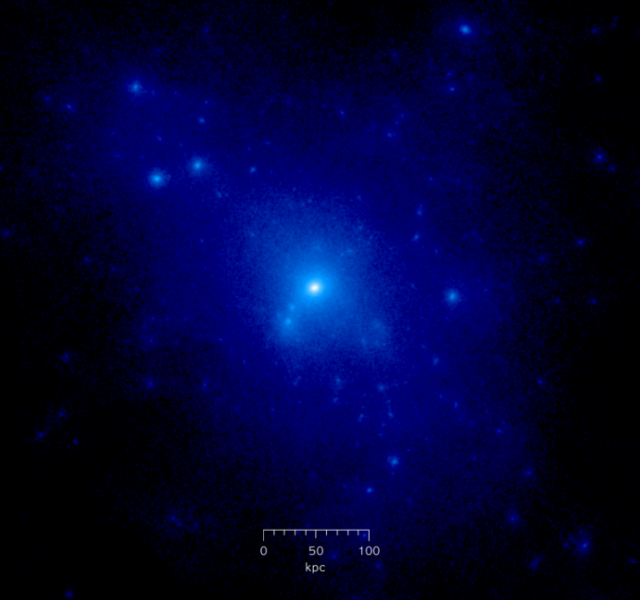
Caption: "Projected density plot of a cosmological redshift z = 2.5 dark halo from a cosmological N-body simulation. The visible part of the galaxy (NOT shown in the image) lies at the dense center of the dark halo and has a diameter of roughly 20 kiloparsecs. There are also many satellite galaxies, each with its own subhalo which is visible as a region of high dark matter density in the image." (Slightly edited.)
The image is false color---but you knew that, right?
- Almost all
galaxies
seem be embedded in
dark matter halos
which are of order 10 times more massive than the
baryonic matter:
ordinary matter (i.e., protons,
neutrons, and
electrons) that
make up stars,
interstellar medium (ISM),
and sometimes
intracluster medium and
intergalactic medium (IGM).
- The dark matter halos
are believed to be roughly spherically symmetric and their centers are
approximately the centers of the galaxies.
The dark matter
probably extends well beyond the observable
galaxies.
- The dark halos
are the main source of gravity
that led to the formation of
the galaxies as we know them.
The dark matter itself is believed to consist of a swarm of exotic particles whose nature we do NOT yet know.
Almost the only effect of the exotic particles is through their gravity.
They are extremely unreactive via other fundamental forces with themselves or anything else.
The dark matter particles form a kind of gas, but NOT an ordinary gas since they barely interact.
They just move around in chaotic orbits which is why they can be modeled by N-body simulations.
- The dark matter particles are
cold dark matter: i.e., nonrelativistic matter.
If they were hot dark matter (i.e., relativistic matter), they would NOT have clump together to have helped form galaxies.
Cosmic neutrinos form at least a part of the hot dark matter of the observable universe, but at present they seem to have little effect on cosmic evolution.
- There are many theories about
what exactly the dark matter
(i.e., cold dark matter) is, but
no consensus theory so far.
- Experimental searches for dark matter
are ongoing and keep giving tantalizing hints of positive results without ever firming up
it seems.
- But maybe there is NO dark matter particles
making up cold dark matter.
Maybe the cold dark matter consists of primordial black holes.
Image link: Wikimedia Commons: File:Dark matter halo.png.
Local file: local link: dark_halo.html.
File: Cosmology file: dark_halo.html.